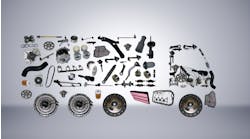The original TMC Recommended Practice (RP) 443 In-Cab Cleaning and Deodorizing Guidelines provide fleets a method for establishing a proper vehicle interior cleaning program.
Recent updates proposed this week from TMC S.4 Cab & Controls study group members provide additional methods to further clean and sanitize a commercial truck cab. The study group issued these updates to help reduce the chance of spreading bacterial and viral germs, in particular the COVID-19 virus.
The updates focus on using chlorine dioxide (ClO2) as a cleaning agent, providing a full list of materials and methods for ensuring the sanitization of in-cab surfaces. In particular, the update features a step-by-step protocol for eliminating odors and disinfecting the cab, as well as best practices for mixing and applying a CIO2 sanitizing and disinfecting solution to in-cab surfaces.
CI02 is a common disinfectant and odor eliminator, already prevalent in many shops. It is available in the form of tablets, and depending on the amount of water added, can be used in a vapor or liquid form.
“A number of industry experts were consulted, as well as U.S. EPA documents, to confirm the capabilities of the [CIO2] product and the effectiveness,” said Mark Winchell, Director of National Accounts, Whiting Systems, Inc. Winchell is also the task force chair for the RP 443 update.
"It has not been readily used or available to shops until recently," Winchell advised, regarding the use of ClO2 for cleaning. "We reopened the in-cab cleaning and deodorizing RP because there was a larger need for a select portion of our fleets to eradicate bed bug infestations.It required very high heat to eradicate [bed bug infestations]. The membership wanted a different method." While this RP update was already in progress, the RP 443 update came into the spotlight because of the additional benefits of safely and effectively eliminating pathogens such as the COVID-19 virus.
The proposed RP 443 update provides detailed instruction on both a thorough vapor cleaning process designed for more extensive, deep cleans of the cab, as well as a liquid treatment using a diluted solution for spot cleaning in high-traffic locations of the cab. The protocols are listed as Tractor Cab Odor Elimination And Disinfecting Protocol, and Liquid Sanitizing And Disinfecting Application Protocol, respectively, in the updated document.
“The vapor treatment is for complete treatment of the cab interior and could be used by itself or in conjunction with the liquid treatment - vapor first then liquid when used together,” Winchell said. “The liquid treatment is performed to treat all surfaces or only high-touch (spot) surfaces. The vapor treatment would be performed to eliminate known odors and pathogens in a cab and would be performed as needed as a decontamination method. The liquid protocol would be done as a regular sanitizing/disinfecting method on a regular basis and when drivers/truck staff is changed.”
Winchell confirmed the vapor treatment takes approximately five to eight hours, minimum. The protocol notes the process can be completed overnight. “Treatment with the liquid product takes less than five minutes of labor and five minutes of dry time for a total of 10 minutes,” Winchell said.
Greg Johnsen, Regional Service Manager for Maverick Transportation LLC, a for-hire carrier headquartered in Little Rock, Ark., confirmed his fleet has implemented these methods for cleaning truck cabs. “After Maverick leadership was brought up to speed on what this product and process could do, they made a decision out of an abundance of caution to use this process on any open unit prior to re-assignment to another driver,” Johnsen said. He confirmed 23 units so far have been cleaned using the processes outlined in the proposed RP 443 update. No Maverick drivers have tested positive for the COVID-19 virus at this time, noted Johnsen.
A number of TMC members worked together to coordinate and ensure the proper techniques listed on these updates, including Winchell and Johnsen. The RP updates also provide step-by-step instructions for tractor bed bug treatment, using the chlorine dioxide cleaning methods.
Winchell confirmed Whiting Systems is one of the suppliers offering chlorine dioxide, though the product is currently in short supply. He advises supply will be replenished soon. The company will also offer training and support for the cleaning methods noted in this TMC update.
TMC has a COVID-19 community forum open to all TMC members. This forum provides full details on the processes and updates to RP 443 mentioned in this article.




